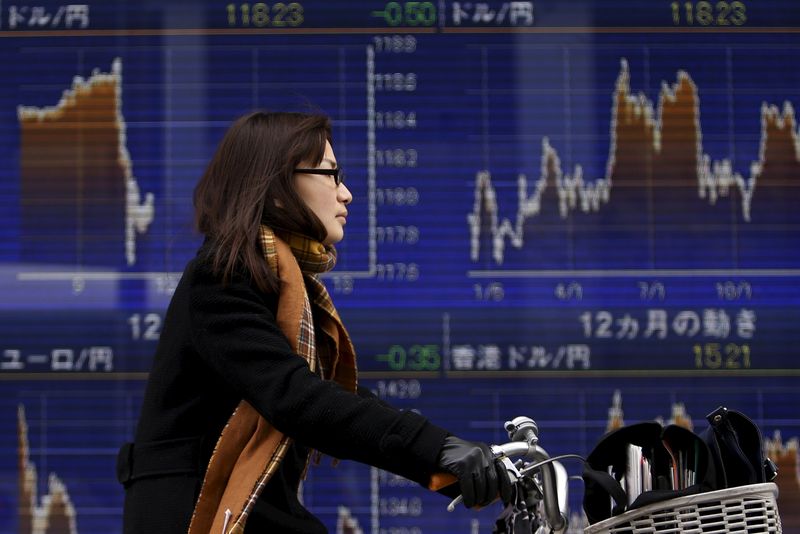By Jamie McGeever
LONDON (Reuters) - World stocks fell for the fifth straight day on Tuesday, anchored near their lowest level in over two years with investors rattled by the slump in oil prices and a surge in offshore Chinese yuan deposit rates.
European stocks, however, recovered from early weakness thanks to a rally in the retail sector. British companies in particular posted strong seasonal updates, lifting the FTSEuroFirst 300 up from a three-month low.
Earlier, the People's Bank of China forced up overnight deposit rates in Hong Kong to 66.8 percent to ease the heavy downward pressure on the yuan, analysts said, an indication of the drastic measures required to cool Chinese market volatility.
As oil slid closer to falling below $30 a barrel for the first time in 12 years, deflation-wary investors in Asia shunned equities and pushed the value of the safe-haven Japanese yen.
"Investors in Europe are shrugging off some of the angst around the Chinese market sell-off and showing some resilience today despite the up and down swings in Asia," said Naeem Aslam, chief market analyst at Avatrade in London.
At 0900 GMT the FTSEuroFirst 300 was up 0.6 percent at 1,342 points, only its second rise this year. Britain's FTSE 100 was up 0.5 percent up, Germany's DAX was up 1.1 percent and France's CAC 40 rose 0.8 percent.
Shares in Morrison's surged 12 percent, Debenhams climbed 15 percent, and Tesco (L:TSCO) rose 5 percent.
MSCI's broadest gauge of world stocks, however, was down 0.2 percent and has not risen since Dec. 29. MSCI's broadest index of Asia-Pacific shares outside Japan was 0.4 percent lower, just shy of its lowest level in four years. It is down more than 9 percent since the start of 2016.
Japan's Nikkei closed 2.7 lower at its lowest level in almost a year, while U.S. futures pointed to a fall of around 0.3 percent at the open on Wall Street.
CHINA WHIRL
With investors still licking their wounds from last year's plunge in global commodity prices and a sharp sell-off in Chinese markets, 2016 has brought about more pain for investment portfolios in the form of a deepening slowdown in the global economy and volatile Chinese markets.
Beijing set another firm fix for its currency, eliminating the gap between offshore and onshore yuan exchange rates. This was done by encouraging state banks to buy up yuan in Hong Kong, driving up the overnight deposit rate fixing to 66.8 percent.
"China is continuing to instil a degree of stability after the sharp volatility at the beginning of the month by announcing stable to firmer fixings," said Mitul Kotecha, currency strategist at Barclays (L:BARC) in Singapore.
"Tighter liquidity has contributed to a squeeze on long USD/CNH positions and will mean investors are wary of shorting CNH in the near term," he said.
The weakness in commodity markets since the start of the year showed no sign of easing, however, as Brent and U.S. crude futures fell around 2 percent to new 12-year lows. Both flirted with a break below $30 a barrel.
The bearish dynamics of slow demand and oversupply have pushed oil down 17 percent so far this year. They also weighed on copper, pushing the industrial base metal down for the fifth day in a row to a fresh 6-1/2-year low of $4,354 a tonne.
Commodity-linked currencies stayed under pressure. The Australian dollar fell 0.5 percent to $0.6955 and the Canadian dollar hit a new 12-1/2-year low of C$1.4269 to the U.S. dollar.
The greenback fell against other major currencies as traders grew wary of how high U.S. interest rates will rise this year, losing 0.3 percent against the yen to 117.40 yen while the euro rose 0.2 percent to $1.0880.
Money market futures <0#FF:> are starting to price out the chance of multiple rate hikes by the Federal Reserve this year, with only a roughly 50 percent chance of a second hike priced in. At the start of the year, futures were fully pricing in two rate increases.

The market is far from convinced that the Fed is going to raise rates in March, after implementing its first rate hike in almost a decade only last month.